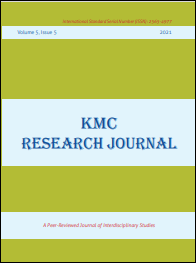Disaster, Women and Vulnerability: A Study of Earthquake 2015 in Nepal
DOI:
https://doi.org/10.3126/kmcrj.v5i5.53574Keywords:
Disaster, Women, Vulnerability, Earthquake, NepalAbstract
This study focuses on the impact of Nepal’s great earthquake 2015 on women and girls. The context of women’s vulnerabilities to disaster is shaped by social differences in roles and responsibilities of women and men. The difference in the division of labor that forces women to stay within the house put them at more risk of death than men. Women are engaged in domestic tasks and caregiving responsibilities, which delay their response and escape from the buildings during emergencies. The lack of education, good health, hygiene and early warning system or absence of disaster awareness made women more vulnerable than men during 2015 earthquake in Nepal. Women relate to different social, physical, psychological, and economic vulnerability in, during and post disaster period. This paper explains the relationship between disaster and its impact over women in the context of Nepal. This article is identified as qualitative research. This research is based on interpretive and descriptive methods. Researcher therefore has collected qualitative data derived from both primary and secondary sources. To analyze and prove the effect of earthquake ethnographically, interviews and key-informants’ interviews are employed. Total 16 interviews and 4 key informants’ interview, and one focus group discussion were held in study area. Researcher also collected secondary data from multiple sources— books, articles, journals, review papers, government documents and archives, nongovernmental reports, newspapers and online materials. The findings of this paper are that women are specifically more vulnerable during disaster because of their socioeconomic and cultural positions. Women encounter different types of problems like social, cultural, economic difficulties. Women’s vulnerability is increased by social differences in roles and responsibilities of male and female during the disaster. The paper strongly argues that gender-based discrimination, inequalities, access to resources and decisionmaking process are the key factors, which directly affect the women during the disaster.
Downloads
Downloads
Published
How to Cite
Issue
Section
License
© Koteshwor Multiple Campus




